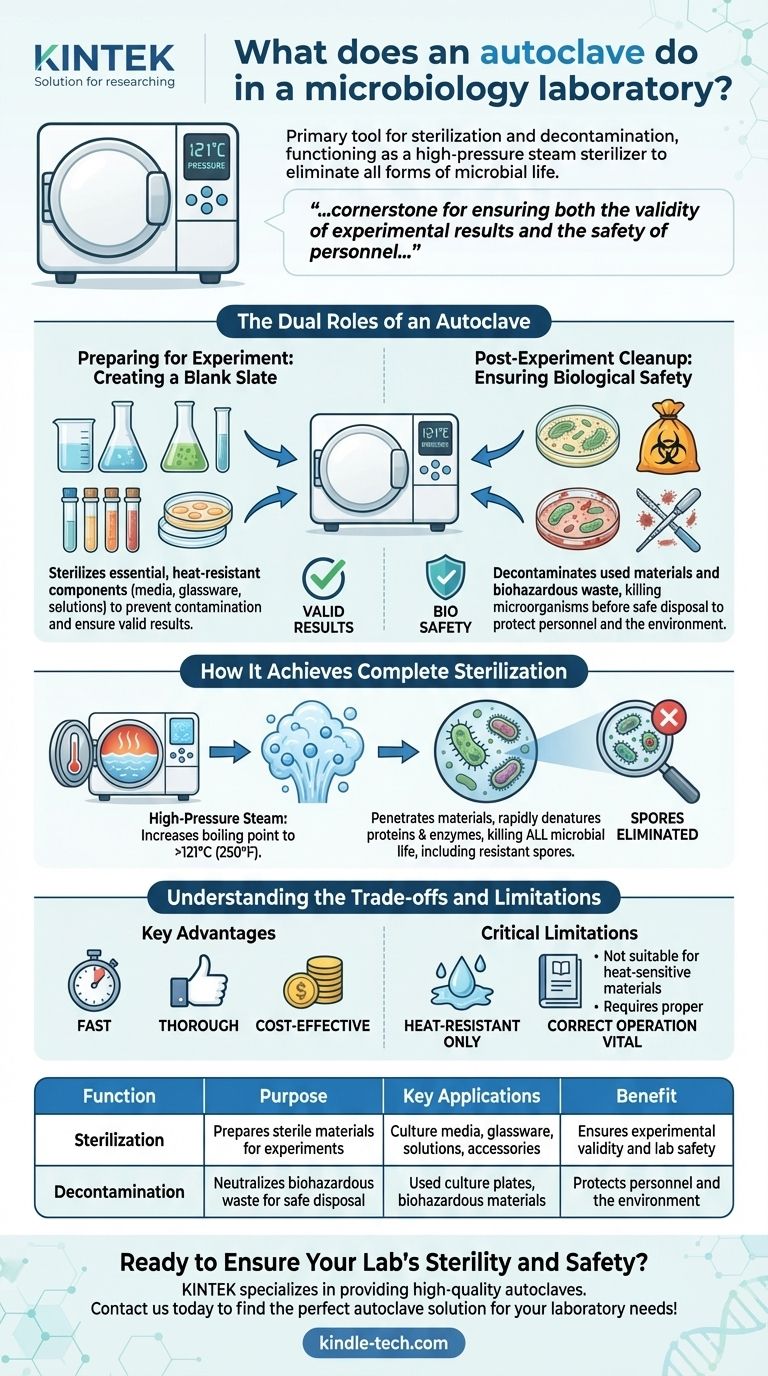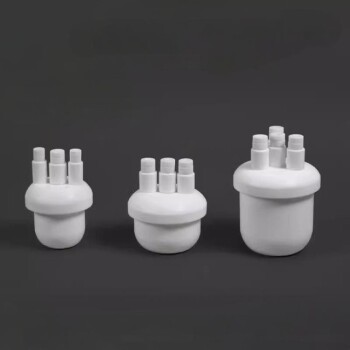In a microbiology lab, an autoclave is the primary tool for sterilization and decontamination. It functions as a high-pressure steam sterilizer, much like a sophisticated pressure cooker, to eliminate all forms of microbial life. Its purpose is twofold: to prepare sterile media and equipment necessary for experiments and to safely neutralize biohazardous waste before disposal.
The autoclave's role is more than simple cleaning; it is a non-negotiable cornerstone for ensuring both the validity of experimental results by preventing contamination and the safety of personnel and the environment by neutralizing biohazards.

The Dual Roles of an Autoclave
The autoclave's function can be divided into two critical phases of the laboratory workflow: preparing materials before an experiment begins and decontaminating them after it concludes.
Preparing for the Experiment: Creating a Blank Slate
To study a specific microorganism, you must start with a completely sterile environment. Any existing microbes on your equipment or in your culture media would contaminate the experiment and invalidate the results.
The autoclave sterilizes all the essential, heat-resistant components needed for research. This includes culture media (liquid, solid, and semi-solid), glassware, solutions, and various laboratory accessories.
This pre-sterilization step ensures that the only organism growing in your culture is the one you intentionally introduced.
Post-Experiment Cleanup: Ensuring Biological Safety
After an experiment, lab materials like used culture plates are filled with billions of microorganisms. These items are considered biohazardous waste and cannot be discarded directly.
The autoclave is used to decontaminate this waste, killing the cultured organisms before disposal. This critical safety protocol prevents the accidental release of potentially harmful or genetically modified microbes into the environment and protects lab personnel from infection.
How It Achieves Complete Sterilization
The autoclave's effectiveness comes from its use of high-temperature steam under pressure, a method far more potent than simple boiling or dry heat.
The Power of Pressurized Steam
By increasing the pressure inside its chamber, the autoclave allows water to boil at temperatures much higher than 100°C (212°F), typically reaching 121°C (250°F) or more.
This superheated, saturated steam can effectively penetrate dense materials. The intense heat rapidly denatures essential proteins and enzymes within microorganisms, killing them completely.
Eliminating Even the Toughest Microbes
This method is powerful enough to destroy all forms of microbial life, including bacteria, viruses, and fungi.
Crucially, it also eliminates highly resistant bacterial spores, which can survive less extreme sterilization methods. This makes autoclaving the gold standard for sterilization in microbiology.
Understanding the Trade-offs and Limitations
While essential, the autoclave is not a universal solution. Understanding its advantages and limitations is key to using it correctly and safely.
Key Advantages in the Lab
The primary benefits are clear: autoclaving is fast, killing most organisms in minutes, and it is thorough, preserving the integrity of materials while ensuring sterility.
It is also a cost-effective way to manage and dispose of biohazardous waste safely, removing the need for specialized disposal services or chemical cleaners.
Critical Limitations and Considerations
The most significant limitation is that autoclaving is only suitable for heat-resistant materials. It cannot be used on heat-sensitive plastics, certain chemical solutions, or biological molecules like proteins that would be destroyed by the high temperatures.
Furthermore, its effectiveness depends entirely on correct operation. Improper loading can create air pockets that prevent steam penetration, and incorrect cycle selection can lead to incomplete sterilization. Validation and careful adherence to protocols are essential for safety and reliability.
Applying Autoclave Use to Your Lab Goal
Your specific objective dictates how and when you will rely on the autoclave.
- If your primary focus is cultivating pure microbial cultures: Use the autoclave to sterilize all media, glassware, and water to prevent cross-contamination and ensure your results are valid.
- If your primary focus is laboratory safety and waste management: Use the autoclave to decontaminate all used materials and biohazardous waste before disposal to protect yourself, your colleagues, and the environment.
- If your primary focus is preparing for sterile procedures: Ensure any heat-resistant tools or instruments are autoclaved to maintain an aseptic, or microbe-free, environment.
Ultimately, mastering the autoclave is fundamental to conducting responsible, repeatable, and safe microbiological research.
Summary Table:
| Function | Purpose | Key Applications |
|---|---|---|
| Sterilization | Prepares sterile materials for experiments | Culture media, glassware, solutions, accessories |
| Decontamination | Neutralizes biohazardous waste for safe disposal | Used culture plates, biohazardous materials |
| Mechanism | Uses high-pressure steam (e.g., 121°C) | Kills all microbes, including resistant spores |
| Benefit | Ensures experimental validity and lab safety | Protects personnel and the environment |
Ready to Ensure Your Lab's Sterility and Safety?
A reliable autoclave is fundamental for valid results and a safe working environment. KINTEK specializes in providing high-quality lab equipment and consumables, including robust autoclaves designed to meet the rigorous demands of microbiology laboratories.
We understand your need for dependable sterilization to protect your research integrity and your team. Let us help you enhance your lab's efficiency and safety protocols.
Contact us today to find the perfect autoclave solution for your laboratory needs!
Visual Guide

Related Products
- Desktop Fast Laboratory Autoclave Sterilizer 20L 24L for Lab Use
- Desktop Fast Laboratory Autoclave Sterilizer 35L 50L 90L for Lab Use
- Portable High Pressure Laboratory Autoclave Steam Sterilizer for Lab Use
- Laboratory High Pressure Steam Sterilizer Vertical Autoclave for Lab Department
- Portable Digital Display Automatic Laboratory Sterilizer Lab Autoclave for Sterilization Pressure
People Also Ask
- What is autoclave in laboratory? Achieve Total Sterility for Your Lab
- Is autoclave the same as sterilization? Unlocking the Key Differences for Lab Safety
- What is an example of autoclave in laboratory? Essential Sterilization for Reliable Science
- Can autoclave sterilize liquid? Master Safe and Effective Liquid Sterilization
- What should be autoclaved in a lab? A Guide to Safe and Effective Sterilization



















